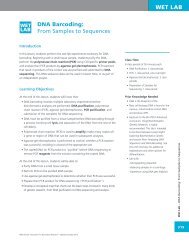LESSON 4 Using Bioinformatics to Analyze Protein Sequences
LESSON 4 Using Bioinformatics to Analyze Protein Sequences
LESSON 4 Using Bioinformatics to Analyze Protein Sequences
You also want an ePaper? Increase the reach of your titles
YUMPU automatically turns print PDFs into web optimized ePapers that Google loves.
<strong>LESSON</strong> 4ProcedureDay OneWarm Up1. As students enter the classroom, display the PowerPoint slide for LessonFour, beginning with Slide #1. This slide highlights Michael Crawford, PhD, abiological anthropologist.<strong>Bioinformatics</strong> & <strong>Protein</strong>s: Slide #12. Have students retrieve Student Handout—Careers in the Spotlight, whichthey were given during Lesson One.3. Students should think about, and write down, the kind of work they thinka biological anthropologist might do (Biological Anthropologist Question#1). This will be revisited at the end of the lesson, including how a biologicalanthropologist might use bioinformatics in his or her job.4. Tell students <strong>to</strong> keep their Careers in the Spotlight Handout available forfuture lessons.PART I: Understanding Reading Frames—Translating DNA in<strong>to</strong> <strong>Protein</strong> on Paper5. Explain <strong>to</strong> students the aims of this lesson. Some teachers may find it useful<strong>to</strong> write the aims on the board.a. Lesson Aim: Use bioinformatics <strong>to</strong>ols <strong>to</strong> study protein translation.b. Lesson Aim: Create multiple sequence alignments using protein sequences<strong>to</strong> answer research questions.Teachers may also wish <strong>to</strong> discuss the Learning Objectives of the lesson, whichare listed at the beginning of this lesson plan.6. Remind students about the bioinformatics analyses they have performed sofar: analyzing DNA sequence data, conducting multiple sequence alignments<strong>to</strong> compare their DNA sequences with other sequences within their group,and generating phylogenetic trees <strong>to</strong> study evolutionary relationships.7. Tell students that the next step will be translating their DNA sequencein<strong>to</strong> protein.<strong>Protein</strong>: A type of molecule found incells formed from a chain of amino acidsencoded by genes. <strong>Protein</strong>s performmany of the functions needed in the cell.Translation: The process by whichmRNA is decoded <strong>to</strong> produce a protein.Lesson 4 – <strong>Using</strong> <strong>Bioinformatics</strong> <strong>to</strong> <strong>Analyze</strong> <strong>Protein</strong> <strong>Sequences</strong>123©Northwest Association for Biomedical Research—Updated Oc<strong>to</strong>ber 2012
















